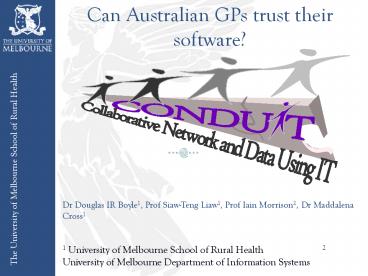Can Australian GPs trust their software - PowerPoint PPT Presentation
1 / 12
Title:
Can Australian GPs trust their software
Description:
Dr Douglas IR Boyle1, Prof Siaw-Teng Liaw1, Prof Iain Morrison2, Dr Maddalena Cross1 ... Seymour. Wodonga. Wodonga. Wangaratta. Corryong. Alexandra. Cobram ... – PowerPoint PPT presentation
Number of Views:25
Avg rating:3.0/5.0
Title: Can Australian GPs trust their software
1
Can Australian GPs trust their software?
Dr Douglas IR Boyle1, Prof Siaw-Teng Liaw1, Prof
Iain Morrison2, Dr Maddalena Cross1
1 University of Melbourne School of Rural Health
2 University of Melbourne
Department of Information Systems
2
Background - Conduit RHAN
- CONDUIT A Collaborative Network and Data using
Information technology - A partnership between 3 local practices, the
Goulburn Valley Division of General Practice and
Goulburn Valley Health - A technical pilot for a Rural Health Academic
Network (RHAN) across the Goulburn Murray Valley - RHAN CONDUIT Sharing clinical information for
audit, research and clinical care
3
Data Quality - Addressing the Issues
- The need for good quality data (and data quality)
is recognized - BUT
- Are we doing enough?
- What about errors due to organizational, software
or site configuration issues? - Databases all exhibit an error rate
- What about poor system design?
- What about unplanned shut-downs, power faults?
- These issues are well known but rarely reported
4
Observational Study
- The data content at three practices from one
Australian computer system was analyzed. - Results are deliberately obfuscated to protect
the vendor software supplier. - An ODBC interface was written for the extraction
of anonymized data (written informed consent). - Tables, linkages key fields were identified.
- Data extracted covered Demographics, medical
history, laboratory results medication - The primary table linkage was via a practice
identifier
5
Observational Study
- An XML Schema was generated covering the database
tables and fields extracted. - This was translated into a Document Object Model
(DOM) using ADO.NET. - This association allowed us to track errors in
expected table and field associations. - Multiple records per individual patient were
identified by comparing standard record linkage
fields. - Data field values out-with normal bounds were
also examined e.g. Blood Pressure.
6
Results
- In one practice, data corruption prevented
operation of the interface. Subsequent analysis
indicates that this may have been due to an
un-planned shut-down during a database write
operation. Other causes are possible. - Rows of data in some tables had no corresponding
master patient identifier (orphaned data) - Prescriptions were recorded as issued, but it was
impossible to tell who whom. - This error was not limited to one table
7
Results
- Some patients had more than one patient
identifier - Problem was identified mainly in patients with
complex histories - Errors were present in 0.1 of patients
- This represents 10 patients / 1,000
- There were also clear data entry faults where
laboratory results were recorded that were not
compatible with life. These did not contribute to
the above error rate and were not further
examined.
8
Discussion and Conclusions
- This small study showed an error rate of 10/1,000
patients even though data entry errors such as
range checking were excluded. - This error rate may be reasonable if the data is
used for large-scale epidemiological research - Is this error rate too high if data is to be used
for clinical care purposes? - Most practices use combinations of electronic and
paper records. Some use all electronic (32.81).
Is it safe to use combinations? - Is a reluctance to embrace fully electronic
solutions justified by the error rates reported?
1 Henderson J., Britt H., Miller G. Extent and
utilisation of computerisation in Australian
general practice MJA 2006 185 84-87
9
Discussion and Conclusions
- There is a clear trend towards the replacement of
paper records with fully electronic records. - This trend raises new issues
- If electronic patient information is pooled
(integrated) one clinical misclassification /
wrong diagnosis can spread to many systems. - There is a limit to how effectively non-coded
clinical data can be shared. - Errors are not necessarily easy to spot.
- Modern DBMSs impose rules and procedures that
can help minimise risk, but - Older e.g. non-relational (pre-relational)
databases should be avoided. - There is no excuse for not validating user input
e.g. BP 1140 / 80
10
Discussion and Conclusions
- Proposition - we need
- A ready assessment of the extent of corruption in
existing systems - To mandate fail-safe strategies in software and
user interface design - To employ strategies to monitor, assess and
improve data quality as part of clinical
governance
The Australian Commission for Safety Quality in
Health Care, Quality Improvement, Scotland,
to name (but not pick on!) two organizations
work hard to improve clinical outcomes, but are
there standards procedures for the management
governance of data quality in clinical
databases?...
11
Discussion and Conclusions
- Strategies need to address (amongst others)
- Training
- Data entry How do I record data accurately?
- Philosophical Why is it important?
- Guidelines for system selection highlighting
capabilities of user interfaces but also system
robustness. - Is data validated?
- Is the data coded and to which standard?
- System Security
- Can procedures be circumvented?...
12
Conclusion
- With increasing reliance on electronic computer
records, physical errors in clinical databases
are an increasing problem. - As database linkages increase, the clinical
implications of a single database error can
multiply. - Quality assurance programmes need to recognize
the importance of data in clinical care and
assess data quality as a routine part of clinical
governance.































